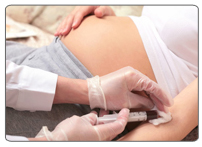Getting pregnant
Pregnancy beginning
Pregnancy monitoring
Clinical and biological examination
Ultrasound imagery
Fetal sampling
Pregnancy illness
Prepared for childbirth
Rhesus négative
Childbirth
Special cases
Post-partum immédiat
Déclaration de naissance et nom de l'enfant
Suites de couches
Allaitement et alimentation
Prime à la naissance (PAJE)
Post natal consultation
Chromosomal abnormalities test

Objective of antenatal examinations is to detect any congenital malformation and fetal diseases leading to handicap after the birth.
Structural chromosomal abnormalities are the main causes of handicap, foremost among which trisomy 21 or mongolism.
The known risk factors of chromosomal abnormalities are the following:
- Women older than 38
- A first child is already carrying a chromosomal abnormality
- Balanced chromosomal abnormality, either for the woman (mother) or the man (father)
- Ultrasound test for nuchal translucency (NT) shows the chance that a baby has a certain birth defect
- Blood tests measure substances found in the blood of all pregnant women. Abnormal maternal serum markers will allow determining the risk of the fetus having certain birth defects. Those blood tests will be suggested to you between the 14 amenorrhea weeks and the 17 amenorrhea weeks + 6 days.
Results of these tests have been scaled, and threshold level is 1/250.- For any results higher to 1/250 (1/200, 1/100, 1/10, 1/2) an amniocentesis will be suggested.
- Results lower than 1/250 (1/300, 1/500, 1/1000, 1/10000), there is no guarantee of zero risk but it is not enough important to think about an amniocentesis
- Maternal serum markers of the 1st trimester: Since summer 2009, a more early blood test combined with ultrasound exam can be suggested by your doctor and realized by recognized ultrasound examiner and biologist.
Last update: 10/2/2013
